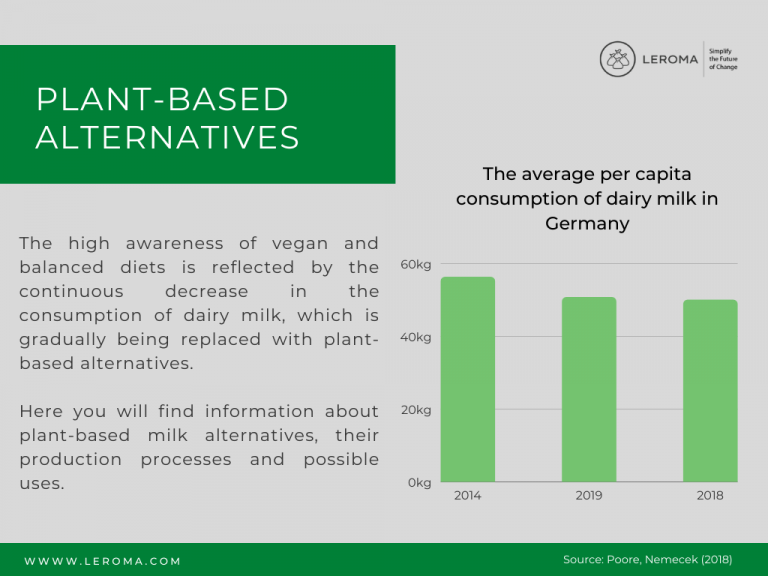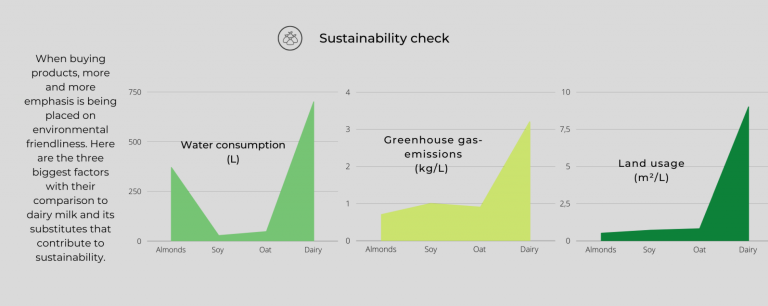The Shift To Plant-Based Milk Alternatives
Plant-based substitutes for dairy milk have come increasingly into focus in recent years and are now indispensable to many consumers. This development is reflected, among other things, by the continuous decline in the consumption of dairy milk. In 2014, the average per head consumption of dairy milk and its products such as cheese, yogurt, and butter was still 56.3 kilograms a year; by 2018, it had fallen by ten percent and in 2019, people then consumed “only” just under 50 kilograms of milk per head. This corresponds to a further decline of three percent within one year. At the same time, plant-based milk alternatives have seen a massive increase in sales of more than 30 %. This clearly shows that companies must react to the trend in order to remain competitive.

The fact that many people are turning away from dairy milk is mainly due to the containing allergens it contains, lactose intolerance and a new awareness, which is reflected in a vegan diet, among other things. Lactose intolerance alone affects at least 10% of Germans, and the trend is growing. Plant-based drinks offer a welcome alternative, as they are lactose-, milk protein- and gluten-free, with the exception of oat drinks, which contain gluten. However, caution is advised with soy drinks, as people who suffer from allergies often also react to soy proteins.
The term “milk” is therefore no longer as clear to end consumers as it was a few years ago. A large number of consumers think not only of dairy milk but also of plant-based alternatives.
In the dairy industry, however, the term “milk” is reserved for products of normal udder secretion, thus products obtained by milking. This is why many manufacturers of plant-based milk alternatives use the terms “drink” or “beverage” for their products.
Possible Uses
Almond beverages are made from almond kernels, which are first roasted and then ground into flour. Then, depending on the manufacturer, the flour is mixed with varying amounts of water and, after a short resting period, the now milky mixture is strained. The finished almond beverages are beige to light cream-colored, depending on the almond content. They have a more or less nutty flavor, influenced by the roasting of the almond kernels, and a slightly sweet note because they are often sweetened with honey, sugar and agave syrup. In terms of taste, they are good for mueslis and desserts. They can also be used for baking, but more for sweet pastries because of the sweet note. Alternatively, there are extra unsweetened almond drinks that offer significantly more uses, including in savory dishes. Generally, almond beverages have a creamy consistency that does well in end products such as yogurt. This is also true for Mondarella, almond milk-based mozzarella, which is creamier than traditional dairy milk mozzarella. Furthermore, a creamy milk foam can be produced, which is ideal for cappuccino or latte macchiato, for example.
In coffee, however, the almond drinks tend to have a flaky consistency at first. This can be solved, however, by warming the drink before adding it to hot coffee or, conversely, cooling it for iced coffee. Incidentally, the milk substitute made from almonds is also used in the beauty industry, for example in creams or masks. Almond drinks are the most popular milk alternative among Germans, according to a 2019 survey by POSpulse, consumed by 67.1% of the 778 respondents.
Second place is taken by soy drinks, which are used by 53.9% of respondents. These are generally produced with the wet process. The soybeans are soaked and then squeezed. The mass is then pureed or ground and the fibrous components filtered out. The finished beverage is slightly yellowish in color and has a somewhat thick consistency that closely resembles conventional dairy milk. The taste is often described as cereal-like and nutty, while for some it is very reminiscent of beans and thus not to everyone’s liking. Many manufacturers therefore also have sweet variants in their range. Soy drinks are suitable for desserts and cereals as well as for pastries, which usually become airy and fluffy. There is also soy yogurt, which is somewhat softer than cow’s milk yogurt, which is why thickeners are sometimes added. Tofu is particularly well known, which can be made from soy drinks by adding coagulants such as citric acid. They are also good for coffee and are offered as a cow’s milk alternative in many cafes, in part because they tend to rarely flake. If this does happen, it helps to use a soy drink variant with a higher fat content or soy cream.
For oat drinks, oat grains are usually dehulled, soaked in water and mashed or ground. Sometimes the mass is fermented briefly and the solid components are then filtered out. The result is a beverage with a somewhat watery consistency, but with a typical white color like dairy milk. Oat beverages have a cereal-like taste due to the gluten they contain and even unsweetened they are slightly sweet, but generally they have a mild aroma. They are suitable for baking, but to make them into yogurt, for example, thickener must be added because otherwise it is too liquid. To coffee, the oat drink adds a cereal note, but it is not always suitable for milk foam. For this purpose, there are extra barista oat milk varieties, some with more fat or less acid, which are now even suitable for latte art.
Gluten allergy sufferers should avoid the oat beverages, however, as they are the only plant-based substitute to milk that contains gluten. According to the POSpulse survey, they are the third most popular plant-based milk alternative, purchased by 49.6% of respondents. In addition to the oat, soy and almond drinks listed here, there are, of course, as already mentioned, many other variants that differ mainly in taste, which offers consumers a wide choice nowadays.
In general, however, all plant-based milk alternatives do not have the same taste, consistency nor the same color as dairy milk. This irritates consumers who are trying the substitutes for the first time. However, the majority of consumers have become used to the difference and greatly appreciate the plant-based milk alternatives. They also credit them with being healthy because they contain less animal fat and soy drinks, for example, have almost as much protein as dairy milk. In the future, however, the sustainability factor in particular will influence consumer’s acceptance.
Sustainability
Consumers are paying more and more attention to the environmental friendliness of products when they buy them. This is why consumption is influenced by where the products come from and how many resources they require. In favor of plant-based milk alternatives is the fact that they generally score better in terms of sustainability than dairy milk, due to the fact that keeping a cow is very intense for all resources. We now take an in-depth look and compare the eco-balance of almond, soy and oat beverages:
Oats and soy can be grown regionally, but about half of the world’s production still comes from South America, where huge areas of the rainforest are being cleared, especially in Brazil and Argentina, to make room for soy production. So when buying, it is also important to look at the country of origin. If the products are to be free of genetic engineering, one falls back on products from Europe. Almonds, which mostly come from Asia, Spain and America, have a comparatively long transport route.

Almond beverages consume the least land, 0.5 square meters per liter, followed by soybeans with 0.7 square meters and oats with 0.8 square meters. By comparison, cow’s milk consumes 9 square meters per liter, more than nine times the amount of land.
Almond beverages also perform best in terms of greenhouse gas production. They produce 0.7 kilograms of greenhouse gas emissions per liter, oat beverages produce 0.9 kilograms, and soy beverages produce one kilogram, but still less than one-third of what a liter of cow’s milk produces. (3.2 kilograms)
If you look at water consumption, on the other hand, almond drinks come off very badly. The production of one liter of almond drink consumes 370 liters of water, making this raw material the sad front-runner among plant-based milk substitutes. By comparison, one liter of oat drink requires 48 liters of water and one liter of soy drink only 28 liters of water. However, one liter of cow’s milk consumes 700 liters of water, almost twice as much as the almond drink.



